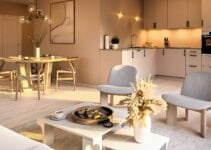Introduction to Common Decorating Mistakes
Decorating a large room presents a unique set of challenges that can often be daunting for even the most seasoned decorators. The sheer scale of the space can make it difficult to create a cohesive and inviting atmosphere. Without a clear plan, it is easy to fall into some common decorating traps that can undermine the overall aesthetic and functionality of the room.

Please, read our post and do not forget to check our YouTube channel “Grig Stamate”:
https://www.youtube.com/@GrigStamate
You will find there, thousands of designing, furnishing, and decorating ideas for your home interior and outdoors.
Allow me to mention one of them:
Trend Alert: Decorate with PAMPAS GRASS – here are the best tips! (video)
One of the primary challenges is the temptation to fill every inch of space with furniture and decor, leading to a cluttered and overwhelming environment. Conversely, some may go to the other extreme, leaving vast empty spaces that make the room feel cold and unwelcoming. Striking the right balance between too much and too little can be tricky.
Another frequent mistake is the improper use of color and lighting. Large rooms can sometimes appear cavernous and impersonal if color choices are too muted or monochromatic. On the other hand, overly bold colors can dominate the room, making it feel chaotic. Similarly, inadequate or poorly placed lighting can leave parts of the room feeling dark and neglected, while overly bright lights can create a harsh atmosphere.
Furniture arrangement is another crucial aspect where mistakes are often made. Placing furniture against the walls can make a large room feel disjointed and empty in the center. It is essential to create intimate seating areas and functional zones that encourage use and interaction within the space.
In this blog post, we will address these common decorating mistakes and provide practical solutions to help you transform your large room into a harmonious and inviting space. Whether you are struggling with furniture placement, color schemes, or lighting, we will guide you through the process with expert tips and strategies.
Mistake 1: Ignoring Proportions and Scale
One of the most common mistakes when decorating a large room is neglecting the importance of proportions and scale. When furnishing expansive spaces, it is crucial to select pieces that complement the room’s dimensions. Choosing furniture that is too small can make the room feel sparse and disconnected, while oversized items can overwhelm and create a cramped atmosphere. Understanding and applying the principles of proportion and scale can transform a large room into a harmonious and inviting environment.
To achieve a balanced look, start by measuring the room and creating a floor plan. This will help you visualize how different pieces will fit and interact within the space. Opt for furniture that suits the room’s scale; for example, a large sectional sofa can anchor a spacious living area, while multiple smaller seating options may work better in a cozy corner or a reading nook. Mixing various sizes of furniture can also add visual interest and prevent monotony.
When it comes to decor, consider the height and width of the room. Tall ceilings can be accentuated with vertical elements such as floor-to-ceiling bookcases or grand chandeliers, while wide walls can be adorned with oversized art or a gallery wall of framed prints. Rugs are another important aspect; a small rug can look out of place in a large room, so choose one that extends under all key furniture pieces to help define the space.
Lighting also plays a significant role in maintaining proper scale. Layer your lighting with a mix of overhead fixtures, floor lamps, and table lamps to ensure adequate illumination and create a cozy ambiance. By paying attention to proportions and scale, you can create a well-balanced, aesthetically pleasing, and functional large room that feels cohesive and inviting.
Mistake 2: Poor Lighting Choices
Poor lighting choices can significantly undermine the aesthetic and functionality of a large room. One common mistake is relying solely on overhead lighting. While overhead lights are essential, depending exclusively on them can result in a flat, uninviting atmosphere. To avoid this, it’s crucial to layer different types of lighting within the space. Incorporating a mix of ambient, task, and accent lighting can add depth and dimension, making the room more versatile and visually appealing.
Ambient lighting serves as the primary source of illumination and sets the overall tone. However, it should be complemented with task lighting, which focuses on specific areas where activities such as reading, cooking, or working take place. Desk lamps, pendant lights, and under-cabinet lighting are excellent examples of task lighting that can enhance functionality. Accent lighting, on the other hand, is used to highlight architectural features, artwork, or other focal points within the room. Wall sconces, track lighting, and picture lights are commonly used for this purpose.
Another critical aspect of lighting a large room is creating zones or separate areas within the space. Strategic placement of different light sources can help define these zones, making the room feel more organized and cohesive. For example, pendant lights over a dining table can create a distinct dining area, while floor lamps and table lamps can establish a cozy reading nook. Additionally, dimmers can be a valuable tool, allowing you to adjust the lighting intensity according to the mood and time of day.
When selecting lighting fixtures, consider the room’s design, color scheme, and furniture layout. Opt for fixtures that complement the overall decor while providing adequate illumination. Positioning is equally important; ensure that lights are evenly distributed to avoid dark corners and shadows. By carefully planning and layering your lighting, you can transform a large room into a warm, inviting, and functional space.
Mistake 3: Neglecting to Create Defined Zones
One common mistake when decorating a large room is neglecting to create defined zones. A vast, open space may initially seem like a blank canvas offering endless possibilities, but without proper segmentation, it can quickly become overwhelming and disorganized. Breaking up a large room into functional areas, such as a seating area, dining area, or workspace, is essential for maximizing both aesthetics and utility.
Furniture arrangement plays a critical role in defining these zones. Strategically placing sofas, chairs, and tables can naturally delineate different sections of the room. For instance, a well-placed sofa can create a clear boundary for a seating area, while a dining table can anchor an eating space. Additionally, using rugs can further emphasize these divisions. A large rug under a seating arrangement not only adds texture and warmth but also visually separates the area from the rest of the room.
Other design elements like lighting and decorative screens can also help in creating distinct zones. Pendant lights or floor lamps can highlight specific areas, enhancing their functional purpose. Decorative screens or open shelving units serve as practical yet stylish barriers, guiding the flow of movement within the room.
Moreover, color schemes can be employed to distinguish different zones. Varying the color palette subtly across different sections of the room can make each area feel unique while maintaining a cohesive overall design. For example, cool tones in a workspace can promote focus, while warmer hues in a seating area can foster relaxation.
Incorporating defined zones within a large room not only enhances its functionality but also makes the space feel more inviting and organized. Thoughtful layering of furniture, rugs, lighting, and color schemes can transform an expansive area into a harmonious and well-utilized living space.
Conclusion: Bringing It All Together
In the journey of decorating a large room, it is imperative to avoid common pitfalls to achieve a harmonious and inviting space. Key mistakes such as neglecting the scale of furniture, overlooking the importance of zones, and failing to incorporate adequate lighting can significantly impact the overall aesthetics and functionality of the room. By selecting appropriately sized furniture, creating defined areas, and layering lighting, you can enhance the comfort and usability of the space.
Additionally, incorporating diverse textures and cohesive color schemes can add depth and interest, preventing the room from feeling monotonous or overwhelming. Balance is essential; a mix of large statement pieces and smaller accents can create visual harmony. Remember, larger spaces offer a unique opportunity to experiment with bold design choices that might be too overpowering in smaller rooms.
Successful large room decoration also involves paying attention to focal points. Whether it’s a striking piece of artwork, a grand fireplace, or a beautiful window view, ensuring that these elements are highlighted can draw the eye and create a sense of purpose within the room. Rugs and other floor treatments can also help anchor furniture groupings, contributing to a more organized and aesthetically pleasing layout.
Finally, personal touches and thoughtful details can transform a large room from a mere space into a welcoming home environment. Adding plants, personal collections, and meaningful decor items can infuse personality and warmth, making the room truly yours.
With careful planning, attention to detail, and a willingness to experiment, decorating a large room can be a rewarding experience. Embrace the process, and you’ll find that creating a beautiful and functional space is well within your reach.
Other related posts from our website:
https://howtobuildahouseblog.com/9-ideas-to-decorate-the-entrance-of-your-house/
Thank you so much for your attention.
Stay tuned. We will upload many other amazing posts to our website and videos onto our YouTube channel.
Thank you so much.
for your time and attention.
Best Regards
See you to another post,
Bye, Bye



No Responses